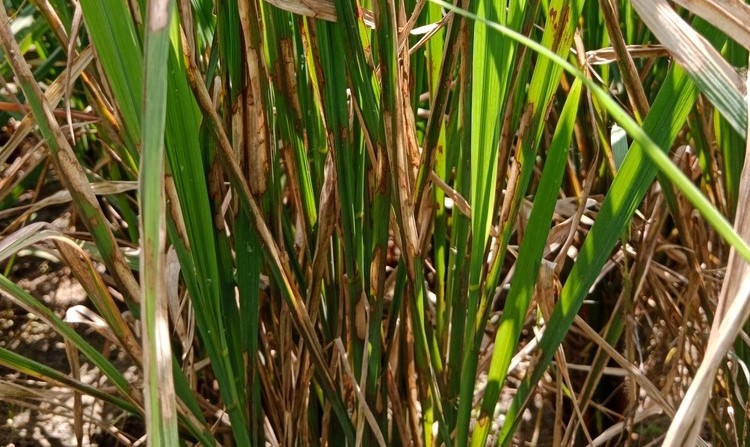Sheath blight
Causative agent: Rhizoctonia solani (Sexual stage: Thanetophorus cucumeris).
- Affect tillering to heading stage .

Symptoms:
- Initial symptoms are noticed on leaf sheaths near water level.
- On the leaf sheath oval or ellipticalor irregular greenish grey spots are formed.
- As the spots enlarge, the centre becomes greyish white with an irregular blackish brown or purple brown border.
- Sheath blight has symptoms similar to stem rot and stemborer infestation.
- To confirm the cause of disease, check for irregular lesions usually found on the leaf sheaths (initially water-soaked to greenish gray and later becomes grayish white with brown margin).
- Also check for presence of sclerotia.
Etiology:
- Mycelium is white when young but turns yellowish or light brown with age.
- Mycelium produces long multinucleate cells that grow approximately at right angles to the main hypha with a slight constriction at the junction of main hypha and branches
Favorable condition:
- High temperature (28−32°C).
- High levels of nitrogen fertilizer.
- Relative humidity of crop canopy from 85−100%.
Survive and spread:
Survive: Sclerotia and mycelia in infected plant debris.
Spread: runner hyphae through water

Management:
- Drain rice fields relatively early in the cropping season to reduce sheath blight epidemics.
- Use fungicide to treat seeds.
- Apply organic amendments, neemcake @ 150Kg/ha or FYM 12.5 tons/ha.
- Avoid flow of irrigation water from infected fields to healthy fields.
- Deep ploughingin summer and burning of stubbles.
- Spray Carbendazim500 g/ha
- Soil application of fluorescens@ of 2.5 kg/ha after 30 days of transplanting (product should be mixed with 50 kg of FYM/Sand and applied)
- Foliar spray fluorescensat0.2% at boot leaf stage and 10 days later